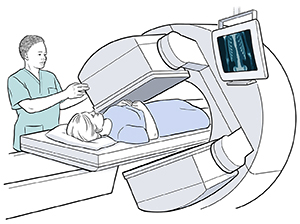Bone Scan
A bone scan is an imaging test that uses a special camera to make images of your bones. It is a type of nuclear imaging exam. It's also called skeletal scintigraphy. The scan uses a small amount of radioactive material called a radiotracer. The radiotracer goes where there is abnormal production of bone.
Why is a bone scan done?
Your healthcare provider may advise a bone scan for any of these reasons:
-
If you have symptoms such as bone pain or break bones often
-
To diagnose arthritis, broken bones, or bone cancer
-
To find cancer in the bones that may have spread from another part of the body (metastasis), such as the breast, lung, or prostate
-
To diagnose infections and joint problems
-
To check joint replacements
-
To monitor or track these diseases and see how well treatment is working
Getting ready for your scan
Your bone scan may take up to a half day. Bring a book to read or an activity to do while waiting to have your scan.
At the hospital, tell the technologist if you:
-
Take any medicines
-
Are pregnant or think you may be
-
Are breastfeeding
-
Had a nuclear medicine scan before
-
Had a recent barium study such as a barium enema, esophagram, or upper GI series
-
Take medicine that has bismuth, such as Pepto-Bismol
-
Have any broken bones or artificial joints
-
Have any allergies
Before the scan
-
You will have an IV (intravenous) line placed into a vein in your arm or hand.
-
A small amount of radioactive material (radiotracer) is injected into your vein.
-
You may be asked to drink several glasses of water and empty your bladder.
-
Your scan may be done right away or a few hours later. If your scan is done right away, you will have a second scan in a few hours.
During the scan
-
You will lie on a narrow imaging table.
-
A large camera is placed close to your body.
-
Stay as still as you can while the camera takes the pictures. This will ensure the best images. You may be asked to change positions during the scan. This is to help get pictures at different positions.
-
The table or camera may be adjusted to take more pictures.
 |
| A large camera takes images of your bones. |
After the scan
-
Drink plenty of water for 1 to 2 days. This is to help clear the tracer from your body. It may take up to 2 days for the tracer to fully leave your body.
-
Your healthcare provider will discuss the test results with you during a follow-up visit or over the phone.
Online Medical Reviewer:
Marianne Fraser MSN RN
Online Medical Reviewer:
Raymond Turley Jr PA-C
Online Medical Reviewer:
Shaziya Allarakha MD
Date Last Reviewed:
2/1/2024
© 2000-2025 The StayWell Company, LLC. All rights reserved. This information is not intended as a substitute for professional medical care. Always follow your healthcare professional's instructions.